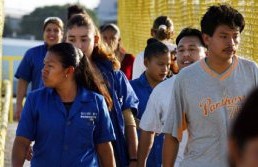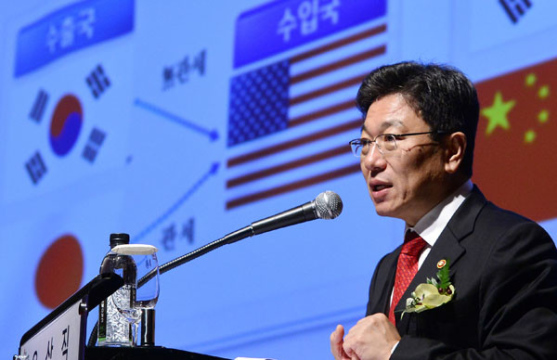
Mexican vs Chinese Factories
With the rising cost of wages in China, manufacturers are increasingly considering Mexico an attractive location to ‘re-shore’ production.
Pope Francis starts today a five-day trip that will take him across Mexico, from south to north, on a route deliberately designed to draw attention to the dangerous journey taken by migrants who seek to reach the United States. He will make five stops during this tour that will purposefully shine a light on some of the country’s biggest problems: inequality, killings and disappearances of women, extortions, and corruption. This focus on Mexico’s gravest ills could make for an uncomfortable visit for the administration.
Upon arrival in Mexico City, the Pope will be received by worshipers who, holding up their mobile phones, are expecting to form two 12 mile (19 km) lines of lights that will illuminate the pontiff’s route from the airport to the Vatican’s mission. After Pope John Paul II, and Benedict XIV, Francis will be the third Pope to visit Mexico. In the nation’s capital he will meet with President Enrique Peña Nieto. In 1917, the Mexican constitution limited the role of the Catholic Church in public life, making this the first time that a Pope is received by the Mexican president in the National Palace.
Following his visit to Mexico City, Francis will visit Ecatepec, a poor and notoriously dangerous suburb of 1.6 million people, known for the highest incidence of feminicide – targeted killings of women. According to the Observatorio Ciudadano Nacional del Feminicidio (OCNF) 1,258 women disappeared in the state between 2011 – 2012, of whom 53% were 10 – 17 years old. Around half of these disappearances are never investigated. On Sunday, dozens of citizens marched through Ecatepec holding crosses, placards and pictures of their missing relatives to highlight the violence tormenting their daily lives ahead of the Pope’s visit.
Francis’s next stop will take him to Chiapas, the poorest and most neglected state in the country. There, he will direct attention to indigenous communities. He will meet with them, lead prayers using indigenous languages, his mass will feature Mayan dance and symbols, and he will issue rules that will allow the use of indigenous languages in church services, something that previous Popes had advised against. Chiapas is also of great importance for the Pope’s attention to migrants during his trip, as this is the most common entry point for Central American migrants on their way to the United States.
Morelia, capital of the Michoacan state and one of the largest sources of immigrants who live in the United States, will be the Pope’s next destination. Tragically, this region is also known for being terrorized by a pseudo-religious drug gang that has threatened, kidnapped and killed rural priests.
The pontiff’s final stop will take him to Ciudad Juarez, across the Rio Grande from El Paso, Texas, where he will visit the Cereso prison, and officiate a mass on a stage about 80 yards away from the border fence. The mass will be intentionally visible from both sides of the border. Francis also plans to extend his hand across the fence that separates Mexico and the United States and will drive along the barrier. The Pope has invited to this service the parents of the 43 students who disappeared in Iguala in 2014. A recent report on this case disputes the official version of events, and the Pope’s attention towards these families could help address the unresolved questions of this case.
From Chiapas to Ciudad Juarez, Francis will find a country that for the last decade has suffered a wave of brutal violence.
The Pope has chosen to make this trip one that highlights Mexico’s biggest problems. From Chiapas to Ciudad Juarez, Francis will find a country that for the last decade has suffered a wave of brutal violence. It is estimated that since 2006, 100,000 people have been killed due to organized crime related incidents. Mexicans are tired of human rights abuses, corruption, and an economic decline that has driven Peña Nieto’s approval ratings to historic lows. The Pope’s focus on the country’s concerns has heightened expectations for his trip, and many are already calling it a “historic encounter.”
What remains to be seen, however, is how explicit or symbolic Francis’ declarations on Mexico’s social ills will be. The numbers of disappearances, killings and tortures have been and are growing substantially, and the government has reacted by denying and hiding these horrors. Even though the Pope is not responsible for solving these problems, his words and actions can at least take this reality from the shade and place it under the spotlight. It is unlikely that Francis will provoke the government by making any direct political statements, but his choice of itinerary in Mexico is already a clear message signaling on where he believes the government should be working.
It is important to remember that the other objective of the pontiff’s visit will be to reactivate the languishing Catholic faith. In Mexico, 83 percent of the population identifies itself as Catholic compared to 95 percent in 1970. Some of the causes of this decline include the growth of Evangelical and Pentecostal churches, the secularization of cities, and migration. Even taken into consideration this decline, Mexico has the world’s second-largest number of Catholics, only preceded by Brazil. Prior to Mexico, the pontiff travelled within Latin America to Brazil, Ecuador, Bolivia, Paraguay, and Cuba, where trips that have featured a historic apology for the Roman Catholic Church’s complicity in Spanish colonialism, reiterated messages on the importance of fighting climate change, income inequality, and injustice. This more human message has attracted more people, especially the younger population, but there is no data to show whether the pope has awakened an interest for the church. If Francis’ visit focuses on this objective, its impact will be more a pastoral than a political one. However, based on his previous trips and declarations, we have seen a Pope who is not afraid of speaking up: just as he extensively discussed migration during his trip to the United States last year, he could do the same in Mexico with that and other issues.
Peña Nieto’s administration prides itself on the Pope’s acceptance to visit the country, as this was already Peña Nieto’s second invitation to Francis. But if the pontiff were to speak his mind and highlight the most controversial issues, just as he has done in multiple occasions, this visit could make some people in the administration really uncomfortable.
With the rising cost of wages in China, manufacturers are increasingly considering Mexico an attractive location to ‘re-shore’ production.
South Korea’s entry into the TPP will promote stronger cooperation between South Korea and Latin America.
Mexican civil society organizations and individuals are pressing for education reform, including reducing the Teachers’ Union.
